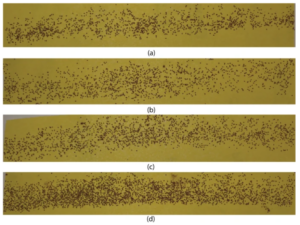
With the release of ChatGPT late last year, discussions about artificial intelligence moved from the realms of Big Tech and Science Fiction to mainstream headlines. Since then, debates about the potential uses and dangers of these tools haven’t left the public consciousness.
In one ironic episode, a prominent Science Fiction magazine had to shut down its submission portal last winter after being inundated with AI-generated short stories. More recently, just this week US President Joe Biden issued an executive order laying out new rules for AI.
It’s not all bad, though. AI and deep learning methods can help with simplifying and innovating. For example, in the sciences it can help assist with processing large datasets and other information.
Which brings me to the main topic of today’s BugBitten blog: a paper recently published in the journal Parasites & Vectors, EggCountAI: a convolutional neural network-based software for counting of Aedes aegypti mosquito eggs by Javed et al. In this article, the authors discuss a free automatic artificial intelligence (AI)-based tool they developed for counting the eggs of Aedes aegypti mosquitoes.
Why develop something like that?
Because, as Javed et al. report, “Aedes aegypti mosquitos are the primary vector of several medically significant viruses, including dengue, Zika, yellow fever, and chikungunya.” And although there has been plenty of research into how to limit or even eliminate mosquito-transmitted pathogens, these diseases are still a major problem all over the world. What’s more, in the future they may even become a bigger concern, as climate change worsens and we become more interconnected.
But still, why the eggs specifically?
Because researchers can actually glean a lot of information just from them. For example, the number of eggs from can be used to estimate the mosquito population in a region. Additionally, certain pathogens can actually change the behavior of the mosquitoes, including their fecundity (aka, how many eggs they lay).
However, as you might imagine, manually counting tiny mosquito eggs can be quite difficult, especially as samples can have high levels of eggs. That’s where the software comes in.

Javed et al. created EggCount AI and trained it on egg samples they had collected. They used two different datasets for the training, one for “micro” images (with egg counts ranging from 13 to 167) and one for “macro” images (ranging from 133 to 624). Afterwards, they put the tool to the test to see how it compared to similar software, validating the counts with a manual count (luckily aided by ImageJ software and not a magnifying glass!).
Overall, EggCount AI performed remarkably well. For micro images, it had an accuracy of 98.88%, and for macro images, 96.06%, outperforming similar tools. As Javed et al. report, by producing accurate egg counts, it can lead researchers “to a deeper understanding of mosquito behaviour and fitness traits.” What’s more, for anyone curious about the tool, EggCount AI is free and available on the article page.
So, what does the future hold for AI for science? It’s tough to say for sure, but clearly it will play a large role moving forward for research. And that’s why Parasites & Vectors recently launched a new article collection, Artificial intelligence, parasites, and parasitic diseases, welcoming articles reporting on the uses of AI and deep learning in parasitology research, such as EggCount AI. We encourage anyone interested in AI applications in science to check in periodically as more papers are added to the collection.

Comments